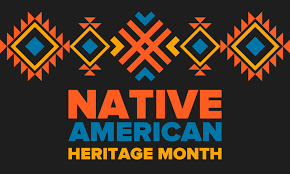November is Native American and Alaska Native Heritage Month

November 15, 2021
While you might have learned that Christopher Columbus “discovered” the Americas, there were already 50 million Native Americans and Indigenous peoples already living there when he arrived on the scene. Of that, 10 million were in what was to become the United States.
It wasn’t until 1990 that Congress passed and President George H. W. Bush signed into law a joint resolution designating the month of November as the first National American Indian Heritage Month (also known as Native American Indian Month). Since 1995 every U.S. President has designated November as a time to celebrate Native American and Alaska Native accomplishments and contributions to society.
Here are some facts everyone should know.
There are over 500 tribes recognized on the federal level in the U.S. and hundreds of cultures, representing over 9 million Native Americans. It is best to refer to an individual’s tribal name whenever possible, and many Indigenous people prefer the terms Indigenous American or American Indian, but according to the Anthropology and Languages department at Encyclopedia Britannica, using Native American is also an acceptable term. If you are unsure of how to address someone, it is always best to simply ask them what they prefer to be called.
Indigenous Americans were not granted citizenship in this country until 1924 when the Indian Citizenship Act was enacted by Congress.
Most Native Americans were able to vote starting in 1924, but it took over 40 years for all 50 states to allow Native Americans to vote due to various state-level laws.
There are currently 574 different federally recognized Native American tribes (approximately 229 are located in Alaska, and the rest are located in 35 other states).
Native American tribes have what is called tribal sovereignty, which means that they have the right to govern themselves—similar to a state government.
78% of Native Americans live outside of tribal areas.
Many Native Americans still face economic obstacles. According to the U.S. Department of Health a Human Services, “The median household income for American Indian and Alaska Natives is $45,448, as compared to $65,845 for non-Hispanic white households… Also, 21.9 percent of this racial group live at the poverty level, as compared to 9.6 percent of non-Hispanic whites, in 2017.”
At one point, there were more than 300 indigenous languages spoken in the United States. Currently there are only 175 remaining. The most popular of these languages is Navajo, with about 170,000 speakers.
Native Americans played a significant role as code talkers in World War I and World War II, leading to extremely successful communication operations. Their impact remained classified until 2002, when Congress acknowledged and celebrated the efforts of these brave soldiers, saying that at “… a time when Indians were discouraged from practicing their native culture, a few brave men used their cultural heritage, their language, to help change the course of history.”
The sport of hockey originated with the Saux, Foxes, and Assiniboine people, who were among the Native American tribes who played a game called “shinny,” where a ball was hit down a field (and in the winter, over ice) using a curved stick.
One of the ways Native Americans celebrate the month is through the “Rock Your Mocs” campaign, launched in 2010, which is an annual event in which Native Americans honor their cultures by wearing moccasins or a turquoise ribbon to work or school. Others wear red on “Red Shawl Day” to bring attention to missing and murdered Indigenous women. Some people attend the National Day of Mourning online or in person in Plymouth, Massachusetts, site of the English settlers’ arrival in 1620. These events spread awareness through hashtags and content on social media.
If you would like to find out more about this topic, check out the links below!
https://americanindian.si.edu/
https://nativeamericanheritagemonth.gov/
https://www.poetryfoundation.org/collections/144560/native-american-poetry-and-culture
https://www.pem.org/explore-art/native-american-art
